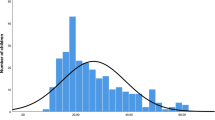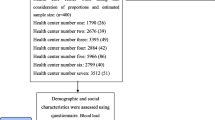Abstract
This study aimed to determine Blood Lead Levels (BLL) in schoolchildren 6–14 years old exposed to industrial sources of lead and evaluated the role of socioeconomic condition. A cross-sectional study was conducted in an area likely to be exposed to industrial pollutants in northern Cali (i.e., distance and wind direction) and in a “non-exposed” area. In children in two schools of corresponding study areas, venous samples (5 ml) were collected to determine BLL by graphite furnace absorption spectrometry. Using regression models, we evaluated the association between risk factors to BLL and the effect of modification with variables of socioeconomic condition. We enrolled 350 schoolchildren. Schoolchildren in the exposed area had higher prevalence of BLL of ≥5 μg/dl (44.2 vs. 8.2 %, p = 0.000) than those in non-exposed area. A positive association was found between exposure and BLL of ≥5 μg/dl (prevalence ratios (PR), 6.68; 95 % confidence interval (95 % CI), 3.95, 11.29). Demographic characteristics and socioeconomic condition such as age (PR, 1.45; 95 % CI, 1.03, 2.04), sex (PR, 1.84; 95 % CI, 1.30, 2.60), race (PR, 2.32; 95 % CI, 1.39, 3.89) and socioeconomic position (SEP; PR, 2.02; 95 % CI, 1.35, 3.04) were statistically significant and independently associated with BLL. There was a synergistic interaction between exposure to the industrial zone and SEP for higher BLL (coefficient, 0.80; 95 % CI, 0.17, 1.43). Residence in the northern urban area of Cali exposed to pollutants of an industrial zone is associated to an increased risk of higher BLL, especially among children from low SEC who are at greater risk of exposure and susceptibility.

Similar content being viewed by others
References
Meyer PA, Pivetz T, Dignam TA, Homa DM, Schoonover J, Brody D (2003) Centers for Disease Control and Prevention. Surveillance for elevated blood lead levels among children—United States, 1997–2001. MMWR Morb Mortal Wkly Rep Surveill Summ 52(10):1–21
Iqbala S, Muntnerb P, Batumanc V, Rabitoa F (2008) Estimated burden of blood lead levels ×5 mg/dl in 1999–2002 and declines from 1988 to 1994. Environ Res 107:305–311
Olivero-Verbel J, Duarte D, Echenique M, Guette J, Johnson-Restrepo B, Parsons P (2007) Blood lead levels in children aged 5–9 years living in Cartagena, Colombia. Sci Total Environ 372:707–716
Miranda ML, Kim D, Galeano MAO, Paul CJ, Hull AP, Morgan SP (2007) The relationship between early childhood blood lead levels and performance on end-of-grade tests. Environ Health Perspect 115(8):1242
Norman R, Mathee A, Barnes B, van der Merwe L, Bradshaw D (2007) Estimating the burden of disease attributable to lead exposure in South Africa in 2000. S Afr Med J 97:773–80
Surkan PJ, Zhang A, Trachtenberg F, Daniel D, Sonja McKinlay, Bellinger DC (2007) Neuropsychological function in children with blood lead levels <10 μg/dl. Neurotoxicology 28:1170–77
Wang Q, Zhao HH, Chen JW, Gu KD, Zhang YZ, Zhu YX, Zhou YK, Ye LX (2009) Adverse health effects of lead exposure on children and exploration to internal lead indicator. Sci Total Environ 407:5986–5992
Canfield RL, Henderson CR, Cory-Slechta DA, Cox C, Jusko TA, Lanphear BP (2003) Intellectual impairment in children with blood lead concentrations below 10 microg per deciliter. N Engl J Med 348(16):1517–26
Lanphear BP, Hornung R, Khoury J, Yolton K, Baghurst P, Bellinger DC (2005) Low-level environmental lead exposure and children’s intellectual function: an international pooled analysis. Environ Health Perspect 113:894–899
Bernard SM (2003) Should the Centers for Disease Control and Prevention’s childhood lead poisoning intervention level be lowered? Am J Public Health 93:1253–60
Reisa F, Sampaioa C, Brantesa A, Anicetoa P, Melimb M, Cardosob L et al (2007) Human exposure to heavy metals in the vicinity of Portuguese solid waste incinerators—part 3: biomonitoring of Pb in blood of children under the age of 6 years. Int J Hyg Environ Health 210:455–459
Farias P, Boria-Aburto V, Rios C, Hertz-Picciotto I, Rojas-Lopez M, Chavez-Ayala R (1996) Blood lead levels in pregnant women of high and low socioeconomic status in Mexico City. Environ Health Perspect 104(10):1070–1074
O’Neill M, Jerrett M, Kawachi I, Levy J, Cohen A, Gouveia N, Wilkinson P, Fletcher T, Cifuentes L, Schwartz J (2003) Health, wealth, and air pollution: advancing theory and methods. Environ Health Perspect 111(16):1861–1870
U.S Environmental Protections Agency. National Ambient Air Quality Standards (NAAGS). http://www.epa.gov/air/criteria.html.
Miller DT, Paschal DC, Gunter EW, Stroud PE, D’Agelo J (1987) Determination of lead in blood using electrothermal atomisation atomic absorption spectrometry, a L’vov platform and matrix modifier. Analyst 112:1701–1704
Barros A, Hirakata N (2003) Alternatives for logistic regression in cross-sectional studies: an empirical comparison of models that directly estimate the prevalence ratio. BMC Med Res Methodol 3:21–46
Coutinho L, Scazufca M, Menezes P (2008) Methods for estimating prevalence ratios in cross-sectional studies. Rev Saude Publica 42(6):1–6
James L, Seng-Tan C, Seng-Chia K (2009) A practical guide for multivariate analysis of dichotomous outcomes. Annals Academy of Medicine 38(8):714–719
CDC (2007) Lead exposure among females of childbearing age—United States, 2004. Morb Mortal Wkly Rep 56(16):397–400
Advisory Committee on Childhood Lead Poisoning Prevention (2012) Centers for Disease Control and Prevention (2012). Low level lead exposure harms children: a renewed call for primary prevention. CDC, Atlanta, GA
Morales L, Gutierrez P, Escarce J (2005) Demographic and Socioeconomic factors associated with blood lead levels among Mexican-American children and adolescents in the United States. Public Health Rep 120:448–454
Lalor G, Vutchkov M, Bryan S (2007) Blood lead levels of Jamaican children island-wide. Sci Total Environ 374(2–3):235–241
Wang S, Zhang J (2006) Blood lead levels in children, China. Environ Res 101:412–418
Rajkumar W, Manohar J, Doon R, Siung-Chang A, Chang-Yen I, Monteil M (2006) Blood lead levels in primary school children in Trinidad and Tobago. Sci Total Environ 361:81–87
Rojas M, Espinosa C, Seijas D (2003) Asociación entre plomo en sangre y parámetros sociodemográficos en población infantil. Rev Saude Publica 37(4):503–509
Been V (1993) What’s fairness got to do with it? Environmental justice and the siting of locally undesirable land uses. Cornell Law Rev 78:1001–1036
Pulido L (2000) Rethinking environmental racism: white privilege and urban development in Southern California. Ann Assoc Am Geogr 90:12–40
Lanphear BP, Hornung R, Ho M, Howard CR, Eberly S, Knauf K (2002) Environ lead exposure during early childhood. J Pediatr 140:40–7 [published correction appears in J Pediatr. 2002; 140:490]
Acknowledgments
Special thanks to schoolchildren living in the study areas for participating and provide valuable information. Additionally, special thanks to the Ministry of Environment (Ministerio de Ambiente, Vivienda y Desarrollo Territorial) for funding support of this project and the regional and local environmental and health authorities for participating in this project.
Conflict of Interest
The authors declare that there is no conflict of interest in conducting this research.
Author information
Authors and Affiliations
Corresponding author
Rights and permissions
About this article
Cite this article
Filigrana, P.A., Méndez, F. Blood Lead Levels in Schoolchildren Living Near an Industrial Zone in Cali, Colombia: The Role of Socioeconomic Condition. Biol Trace Elem Res 149, 299–306 (2012). https://doi.org/10.1007/s12011-012-9429-2
Received:
Accepted:
Published:
Issue Date:
DOI: https://doi.org/10.1007/s12011-012-9429-2




